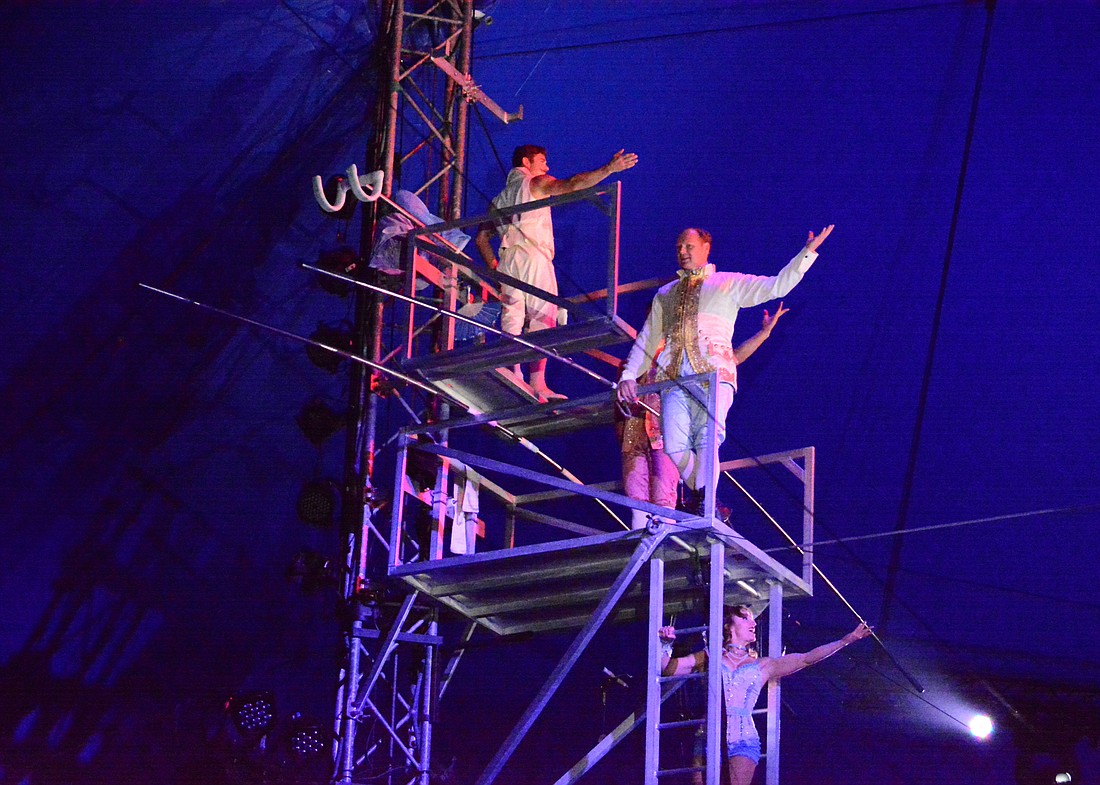- April 25, 2024
-
-
Loading

Loading

Tightrope walking legend Nik Wallenda had been replaying the worst day of his life over and over in his mind.
And yet, barely 24 hours after watching five of his troupe members topple from more than 30 feet above ground — and he himself hanging from the wire with two others — he again was performing on the wire at a Feb. 9 dress rehearsal for Circus Sarasota’s “Synergy.”
By opening night, Feb. 10, two of Wallenda’s teammates who had been involved in the fall, Zebulon Fricke and Alec Bryant, were performing alongside Wallenda. They both had been hospitalized but suffered the least serious injuries.
“It doesn’t make sense to other people,” said Wallenda, whose aunt, Rietta Wallenda, and sister, Lijana, were still hospitalized Tuesday but were expected to make complete recoveries. “I feel no greater peace than when I’m on that wire. It’s harder on the ground.”
Fricke called working through what happened “a process.”
But to not perform? Not an option.
“It’s in your blood,” said Fricke, who sported a nickel-sized bruise under his left eye.
Nik Wallenda’s mantra has been “never give up,” and the accident put it to the test. Before performing, he sought the blessing of each of his troupe members independently, and received a unanimous “yes” to perform.
Fellow circus performers say it’s part of the business.
“There’s nothing glamorous about the ‘show must go on,’” said Nik Wallenda’s uncle and tightrope walker Tino Wallenda, of the Flying Wallendas troupe. “It is simply the practical base necessity of life.”
Circus Sarasota performer Emily VanDyke agreed.
“We all want to perform well because this is our work,” she said. “We feel we have to do well to honor the Wallendas in the hospital. The Wallendas even performed tonight because they felt they needed to continue, and in the circus, we always continue. I send all my love to them, and I know all of the circus people feel for them. But the circus must go on.”
Circus Sarasota performer Alesya Gulevich, who is listed in The Guinness Book of World Records three times, including for hula hooping with 107 hoops, said overcoming tragedy leads to personal and professional growth.
“If you look at anything — business, sports or education — if you want to achieve something, you have to overcome,” said Gulevich, who uses 50 hula hoops in her show with Circus Sarasota. “It helps you push forward.”
Each performer’s act is one of hours and years of training boiled down to several minutes. It reflects passion for his or her art, discipline and focus.
“This focus translates into everything else,” Gulevich said. “It’s not like you forget. There’s nothing more important than life. You have to live and go forward, not backward.
“It’s easy to give up,” she said. “It’s better maybe to fail. It’s better to try again.”
Kay Rosaire, a seventh-generation circus performer who does animal demonstrations at her Big Cat Habitat and Animal Sanctuary, said the “show must go on” concept came from years ago when the circus traveled to towns and fans sometimes waited six months or more to see lions, tigers and bears, clowns and other acts. At first, performers didn’t want to disappoint them. Later, it became a badge of pride.
“Most performers, the minute they enter the ring, that becomes their immediate world,” said Rosaire, who has performed with a broken foot, double pneumonia and other ailments. “You’re risking your own life at the same time. When you focus on doing your craft, you can do it. It’s extremely hard. You’re crying back stage and then you’re in the public putting your best foot forward.
“For those few minutes you’re actually performing, there’s thousands of hours that go into training,” she said. “Those few minutes in the ring are just part of the reward. It makes you feel better, that you can continue and life will go on.”
Ashley Pletcher, an Alanian rider who showcases the Cossack trick riding style, agreed.
“Circus is a family,” she said. “No matter what happens, we pull together and be there for each other. It takes a lot to pull everything back together, but it’s our profession and accidents happen. It’s normal for us.”
East County’s Monica Welde, who ran Bearadise Ranch with her husband, Johnny, went back to performing with her grizzly bears just a day after her husband’s Feb. 2 funeral service. He died in his sleep Jan. 25.
“We all know the dangers,” Welde said. “We love our craft. The saying, ‘The show must go on’ comes from our spirit.”
Berkley Mason contributed to this report.